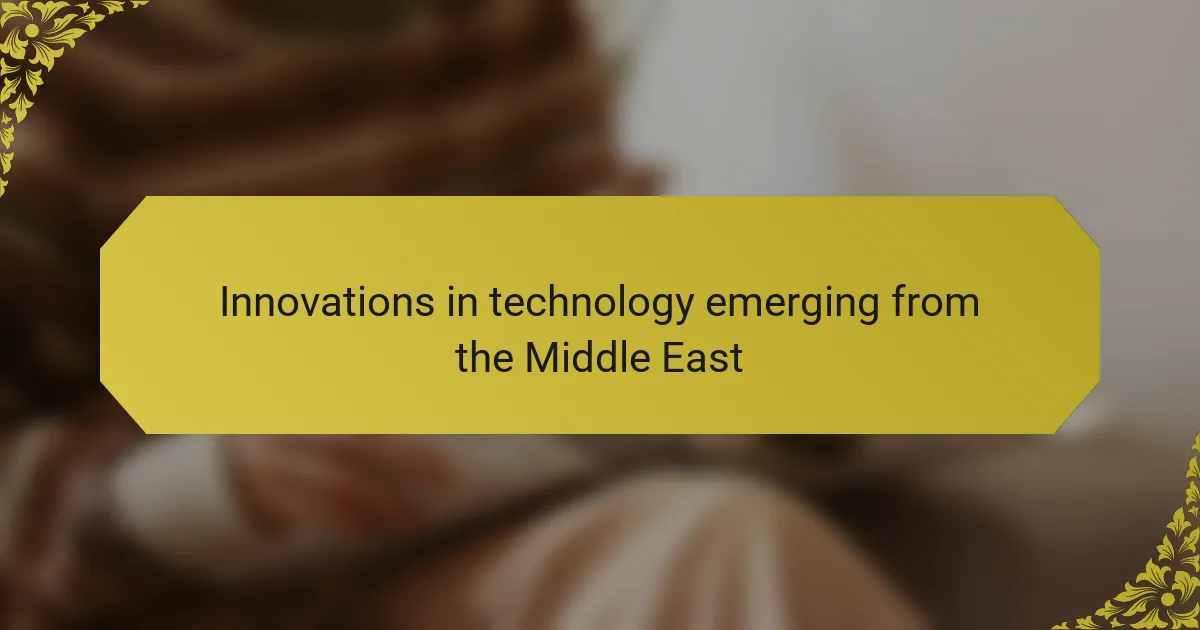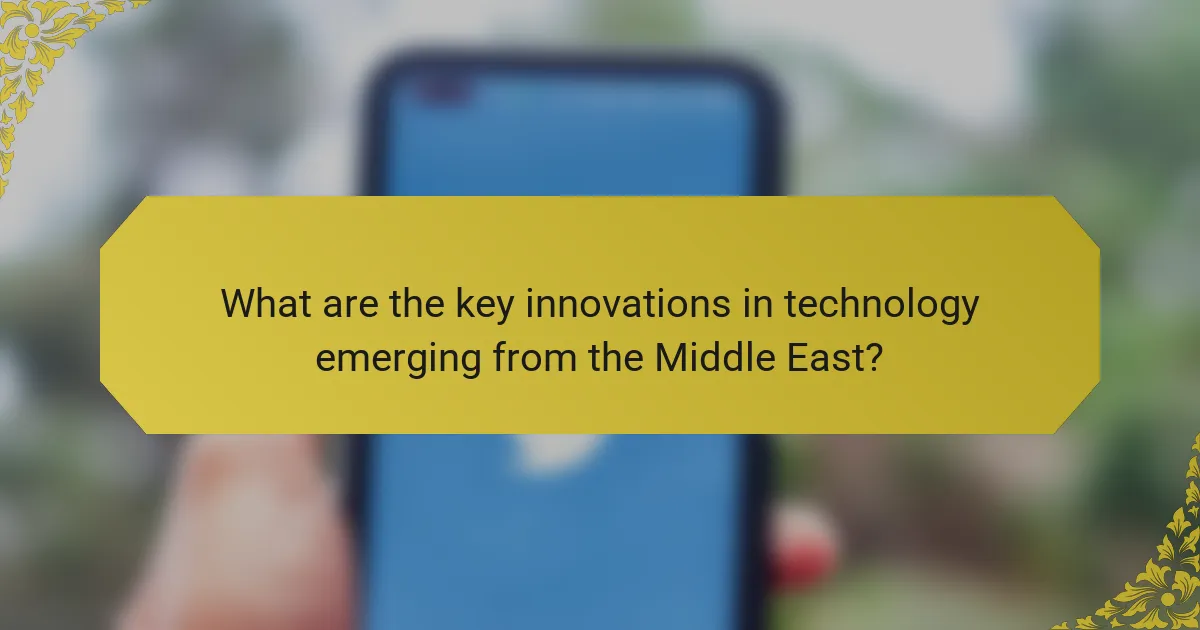
What are the key innovations in technology emerging from the Middle East?
Key innovations in technology emerging from the Middle East include advancements in artificial intelligence, renewable energy, and fintech solutions. Countries like the UAE and Israel are leading in AI research and development. The UAE’s investment in smart city initiatives exemplifies this trend. Renewable energy projects, particularly solar power, are prominent in Saudi Arabia and the UAE. The Mohammed bin Rashid Al Maktoum Solar Park is one of the largest in the world. In fintech, startups in countries like Bahrain and Israel are revolutionizing digital banking and payment systems. These innovations position the Middle East as a growing hub for technological advancement.
How is the Middle East contributing to global technological advancements?
The Middle East is significantly contributing to global technological advancements through investments in startups and innovation hubs. Countries like the UAE and Israel are fostering tech ecosystems that attract global talent. The region is known for its rapid adoption of technologies such as artificial intelligence and blockchain. For instance, the UAE aims to be a leader in AI by implementing the UAE Strategy for Artificial Intelligence. Israel is recognized for its high number of tech startups per capita, focusing on cybersecurity and agritech. Additionally, initiatives like Saudi Arabia’s Vision 2030 emphasize diversifying the economy through technology. The Middle East’s strategic investments in research and development further enhance its role in global tech innovation.
What specific sectors are seeing the most innovation in the Middle East?
The specific sectors seeing the most innovation in the Middle East include technology, healthcare, and renewable energy. The technology sector is rapidly advancing, with significant investments in artificial intelligence and fintech. In healthcare, telemedicine and health tech startups are transforming patient care. Renewable energy is also a key focus, particularly solar and wind energy projects. According to the International Renewable Energy Agency, the Middle East is expected to invest over $200 billion in renewable energy by 2030. These sectors are driving economic diversification and technological advancement in the region.
How do cultural factors influence technological innovation in this region?
Cultural factors significantly influence technological innovation in the Middle East. The region’s rich history and diverse cultural heritage foster creativity and unique perspectives. Traditional values can encourage community-oriented innovations, particularly in sectors like agriculture and renewable energy. Additionally, the emphasis on education and knowledge-sharing promotes research and development initiatives. For instance, countries like Israel invest heavily in technology startups, driven by a culture of entrepreneurship and risk-taking. Furthermore, local customs and social norms shape the adoption of new technologies, impacting their success and integration. Overall, cultural dynamics play a crucial role in shaping the innovation landscape in the Middle East.
What role do governments play in fostering technology innovation in the Middle East?
Governments in the Middle East play a crucial role in fostering technology innovation. They implement policies that promote research and development. Many governments establish funding programs for startups and tech initiatives. They also create regulatory frameworks that encourage investment in technology sectors. Public-private partnerships are often encouraged to drive innovation. Additionally, governments invest in education and training programs to build a skilled workforce. For example, the UAE’s Vision 2021 emphasizes innovation as a national priority. These efforts contribute to a thriving tech ecosystem in the region.
Which policies are most effective in promoting tech startups?
Government grants and funding programs are among the most effective policies for promoting tech startups. These financial incentives provide crucial capital for early-stage companies. Tax incentives also play a significant role by reducing the financial burden on startups. For instance, countries like the UAE offer tax holidays to attract tech entrepreneurs. Additionally, regulatory reforms that streamline business registration can enhance the startup ecosystem. Programs that foster collaboration between startups and established firms can drive innovation. Access to mentorship and networking opportunities is another vital policy element. Countries like Israel have successfully implemented these strategies, resulting in a robust tech startup scene.
How do government initiatives impact research and development?
Government initiatives significantly impact research and development by providing funding, resources, and strategic direction. These initiatives often prioritize key sectors such as technology and innovation. For instance, in the Middle East, countries like the UAE and Saudi Arabia have launched programs to enhance R&D capabilities. The UAE’s National Innovation Strategy aims to position the country as a global hub for innovation. Additionally, Saudi Arabia’s Vision 2030 emphasizes diversifying the economy through technological advancements. These government actions lead to increased collaboration between public and private sectors. They also foster partnerships with international research institutions. As a result, there is a measurable increase in patents and technological breakthroughs. Data shows that government funding can boost private sector investment in R&D by up to 30%.
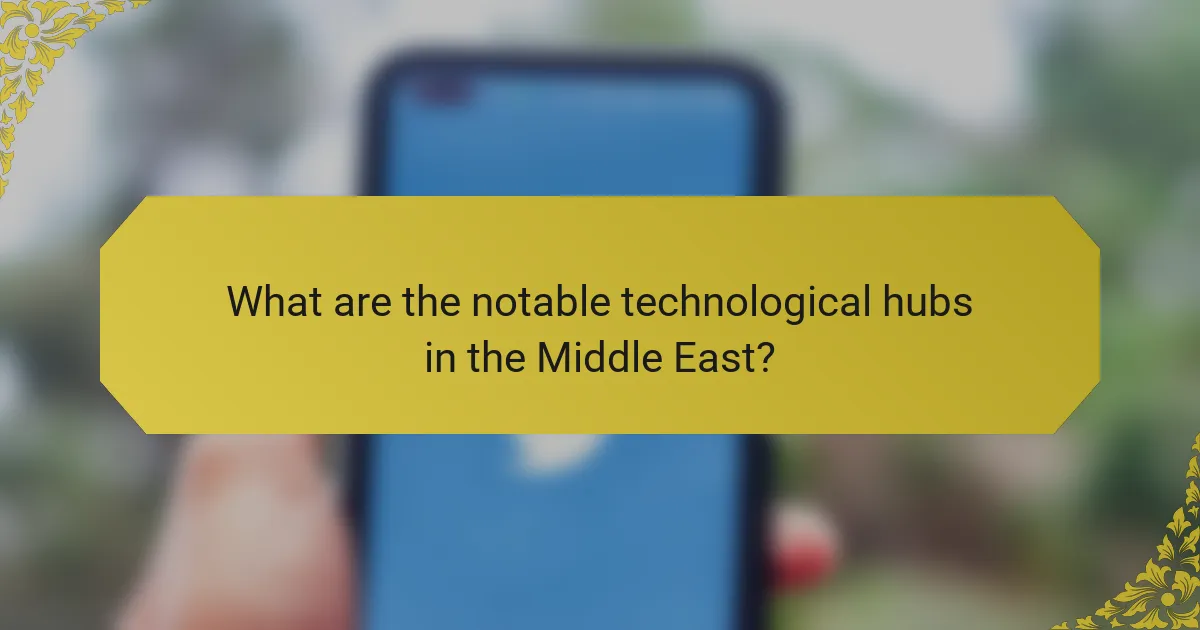
What are the notable technological hubs in the Middle East?
The notable technological hubs in the Middle East include Dubai, Tel Aviv, and Riyadh. Dubai is known for its rapid development in tech startups and innovation. The Dubai Internet City hosts many global tech firms. Tel Aviv is recognized as a leading startup ecosystem, often referred to as “Silicon Wadi.” It has a high concentration of tech companies and venture capital. Riyadh is emerging as a tech hub with significant government investment in technology and innovation. The Saudi Vision 2030 initiative aims to diversify the economy and boost the tech sector. These cities are pivotal in shaping the technological landscape of the region.
Which cities are leading the charge in tech innovation?
Dubai and Tel Aviv are leading the charge in tech innovation. Dubai has positioned itself as a global technology hub with initiatives like Smart Dubai. The city invests heavily in artificial intelligence and blockchain technology. Tel Aviv is recognized for its vibrant startup ecosystem and advanced cybersecurity solutions. It ranks among the top cities for venture capital investment. Both cities attract international talent and foster collaboration between startups and established companies. Their focus on innovation drives economic growth and positions them as leaders in the tech sector.
What infrastructure supports technology growth in these cities?
Cities in the Middle East support technology growth through advanced digital infrastructure, robust telecommunications networks, and innovation hubs. Digital infrastructure includes high-speed internet connectivity and cloud computing services. Telecommunications networks provide widespread mobile coverage and accessibility. Innovation hubs, such as tech parks and incubators, foster collaboration among startups and established companies. These hubs often receive government support and funding to encourage technological advancements. Additionally, educational institutions partner with tech companies to enhance workforce skills. This collaborative environment accelerates the development of new technologies and solutions.
How do educational institutions contribute to the tech ecosystem?
Educational institutions contribute to the tech ecosystem by providing research, skilled workforce, and fostering innovation. They conduct research that drives technological advancements. Universities often collaborate with tech companies on projects. This collaboration leads to practical applications of research findings. Educational institutions also offer specialized programs in technology fields. These programs equip students with relevant skills for the job market. According to the World Economic Forum, higher education institutions significantly influence regional innovation. They create incubators and accelerators to support startups. This nurturing environment helps transform ideas into viable businesses.
What collaborations exist between the public and private sectors in technology?
Collaborations between the public and private sectors in technology include joint ventures, public-private partnerships, and research collaborations. These partnerships often focus on developing innovative solutions that address societal challenges. In the Middle East, initiatives like the Dubai Smart City project exemplify such collaboration. This project involves both government entities and private tech firms working together to enhance urban living through technology. Additionally, the UAE’s National Innovation Strategy promotes collaboration to foster a knowledge-based economy. Such efforts have resulted in advancements in smart infrastructure, healthcare technology, and renewable energy solutions.
How do partnerships enhance innovation capabilities?
Partnerships enhance innovation capabilities by combining diverse expertise and resources. Collaborative efforts lead to the sharing of knowledge and ideas. This synergy fosters creative problem-solving and accelerates the development of new technologies. For instance, research shows that companies engaged in partnerships are 2.5 times more likely to innovate successfully. By pooling financial resources, partners can undertake larger projects that may be too risky for a single entity. Additionally, partnerships often provide access to new markets and customer insights. This broader perspective can inspire innovative solutions tailored to specific needs. In the Middle East, partnerships between tech firms and academic institutions have led to significant advancements in fields like artificial intelligence and renewable energy.
What examples of successful collaborations can be highlighted?
Successful collaborations in technology from the Middle East include the partnership between the UAE and Israel in the tech sector. This collaboration has led to advancements in cybersecurity and artificial intelligence. Another notable example is the collaboration between Saudi Arabia and SoftBank for the Vision Fund, which focuses on investing in innovative startups. The Qatar Science and Technology Park has partnered with global tech firms to foster research and development. Additionally, the Bahrain Economic Development Board collaborates with various fintech companies to enhance digital banking solutions. These collaborations have significantly contributed to the region’s technological growth and innovation landscape.
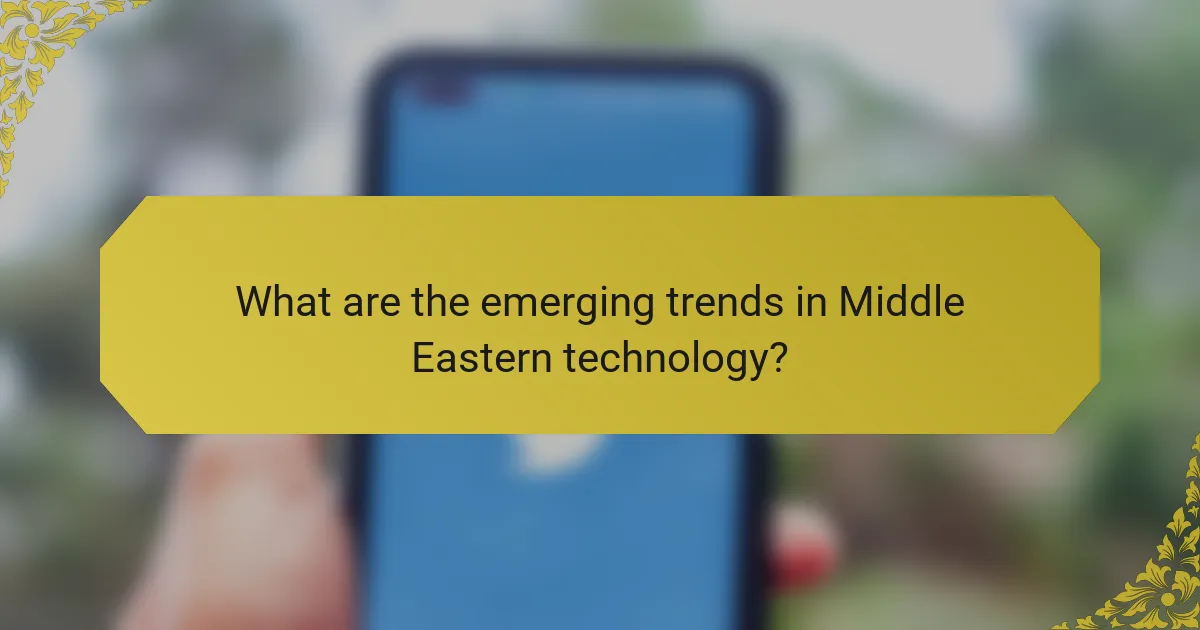
What are the emerging trends in Middle Eastern technology?
Emerging trends in Middle Eastern technology include advancements in artificial intelligence, blockchain, and renewable energy. The region is increasingly focusing on AI applications in healthcare, finance, and smart cities. Blockchain technology is being adopted for secure transactions and supply chain management. Countries like the UAE are investing heavily in solar and wind energy solutions. The growth of tech startups is also notable, with significant venture capital investment. Additionally, there is a push for digital transformation across various sectors. These trends are supported by government initiatives aimed at fostering innovation and attracting talent.
How is artificial intelligence being utilized in the region?
Artificial intelligence is being utilized in the Middle East across various sectors. In healthcare, AI enhances diagnostic accuracy and patient care. For instance, AI algorithms analyze medical images to detect diseases early. In finance, AI streamlines operations and improves fraud detection. Banks use machine learning models to assess credit risk. The education sector employs AI for personalized learning experiences. AI-driven platforms adapt content to individual student needs. Additionally, AI is transforming logistics and supply chain management. Companies optimize routes and reduce costs using predictive analytics. These applications demonstrate the region’s commitment to integrating AI into key industries.
What industries are adopting AI technologies?
Various industries are adopting AI technologies. Key sectors include healthcare, finance, retail, and manufacturing. In healthcare, AI enhances diagnostics and patient care. The finance industry utilizes AI for fraud detection and algorithmic trading. Retail companies implement AI for personalized shopping experiences and inventory management. Manufacturing benefits from AI through automation and predictive maintenance. According to a report by McKinsey, AI adoption in these sectors is accelerating, driven by the need for efficiency and innovation.
What challenges does AI face in the Middle East?
AI faces several challenges in the Middle East. Limited infrastructure hinders the development and deployment of AI technologies. Many countries lack sufficient internet connectivity and data centers. Additionally, regulatory frameworks are often underdeveloped or inconsistent. This creates uncertainty for businesses and innovators. There is also a shortage of skilled professionals in AI and data science. Educational institutions struggle to keep pace with industry needs. Cultural and political factors can impede collaboration and investment in AI projects. Geopolitical tensions may affect cross-border partnerships necessary for technological advancement.
What impact does blockchain technology have in the Middle East?
Blockchain technology significantly impacts the Middle East by enhancing transparency and efficiency in various sectors. Governments in the region are adopting blockchain for public services and administrative processes. This adoption reduces corruption and increases trust among citizens. For instance, Dubai aims to become the first blockchain-powered government by 2021. The technology also facilitates secure transactions in finance and trade. The UAE has launched several blockchain initiatives to improve logistics and supply chain management. Additionally, blockchain supports the development of smart contracts, streamlining business operations. The Middle East’s focus on blockchain positions it as a leader in digital innovation.
How is blockchain being applied in various sectors?
Blockchain is being applied in various sectors such as finance, supply chain, healthcare, and real estate. In finance, it enables secure and transparent transactions. This reduces fraud and increases efficiency. In supply chain management, blockchain enhances traceability of products. Companies can verify the origin and journey of goods. In healthcare, it secures patient data and improves interoperability. This facilitates better data sharing among providers. In real estate, blockchain simplifies property transactions. It reduces paperwork and speeds up the process. The World Economic Forum reports that 10% of global GDP could be stored on blockchain by 2027. This shows significant potential across sectors.
What are the regulatory challenges surrounding blockchain in the region?
Regulatory challenges surrounding blockchain in the region include a lack of clear legal frameworks. Many countries in the Middle East have not established specific regulations for blockchain technology. This creates uncertainty for businesses looking to adopt blockchain solutions. Additionally, varying regulations across different countries complicate cross-border transactions. Compliance with anti-money laundering (AML) and know your customer (KYC) regulations is often unclear. There is also a concern regarding data privacy and protection laws. Furthermore, the rapid pace of technological advancement outstrips regulatory responses. These challenges hinder the growth and adoption of blockchain in the region.
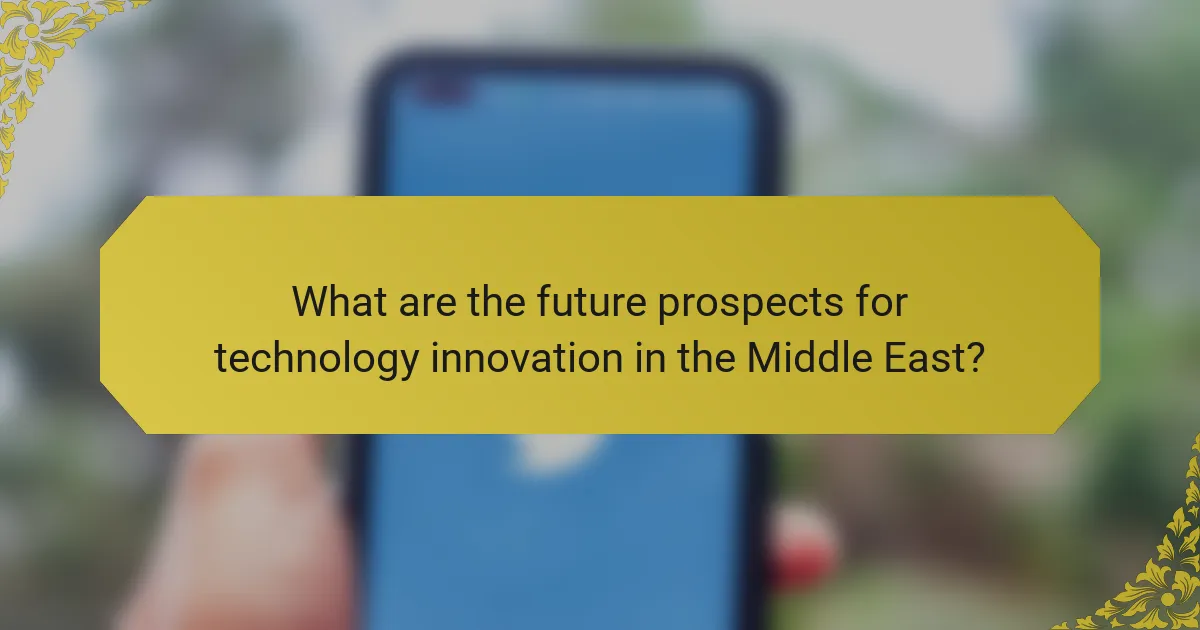
What are the future prospects for technology innovation in the Middle East?
The future prospects for technology innovation in the Middle East are promising. Countries in the region are investing heavily in technology infrastructure. For instance, the UAE has allocated billions for its National Innovation Strategy. This strategy aims to position the country as a global hub for innovation by 2021. Saudi Arabia is also making strides through its Vision 2030 initiative. This initiative emphasizes diversifying the economy and enhancing technological capabilities. The region’s youth population is tech-savvy and eager to engage in startups. Additionally, the rise of smart cities and digital transformation initiatives is fostering innovation. According to a 2021 report by PwC, the Middle East’s digital economy could reach $320 billion by 2030. These developments indicate a robust future for technology innovation in the Middle East.
What skills are essential for the next generation of tech innovators?
The essential skills for the next generation of tech innovators include programming, critical thinking, and adaptability. Programming skills enable innovators to create software solutions and understand technology deeply. Critical thinking helps them analyze problems and devise effective solutions. Adaptability is crucial in a fast-evolving tech landscape.
Additionally, collaboration skills are important for working in diverse teams. Effective communication is necessary for sharing ideas and concepts clearly. Knowledge of data analysis allows innovators to make informed decisions based on trends. Finally, creativity drives innovation and the development of unique solutions. These skills collectively empower tech innovators to thrive in the competitive landscape of technology.
How can education systems adapt to meet future tech demands?
Education systems can adapt to meet future tech demands by integrating technology into curricula. This includes teaching coding, data analysis, and digital literacy from an early age. Schools should also emphasize STEM (Science, Technology, Engineering, Mathematics) education to prepare students for tech careers. Collaboration with tech companies can provide real-world skills and internships. Furthermore, professional development for teachers in tech tools is essential. Research shows that 65% of jobs require skills related to technology. Adapting to these demands ensures students remain competitive in a rapidly evolving job market.
What role will international collaboration play in future innovations?
International collaboration will be crucial for future innovations. It enhances knowledge sharing among diverse teams. Collaborative efforts can accelerate research and development processes. Access to global markets expands opportunities for innovation. Joint projects often lead to increased funding and resources. For example, partnerships between Middle Eastern countries and tech firms have produced groundbreaking advancements. Collaborative initiatives can also address global challenges, such as climate change and health crises. Overall, international collaboration fosters an environment conducive to creative solutions and technological progress.
What best practices can be adopted to nurture tech innovation in the Middle East?
Fostering tech innovation in the Middle East requires a multi-faceted approach. First, establishing supportive regulatory frameworks is essential. These frameworks can encourage startups and protect intellectual property. Second, increasing investment in research and development is crucial. According to the World Bank, investment in R&D can significantly boost innovation output. Third, fostering collaboration between academia and industry can drive practical applications of research. Universities can partner with tech companies to create incubators and innovation hubs. Fourth, enhancing access to funding for startups is necessary. Reports indicate that venture capital funding in the region has been growing, yet more is needed. Fifth, promoting STEM education can equip the workforce with necessary skills. Countries like the UAE have already started initiatives to improve STEM education. Lastly, creating a culture of innovation through public awareness campaigns can inspire entrepreneurship. This approach has been successful in various global tech hubs.
How can startups leverage local resources for growth?
Startups can leverage local resources for growth by utilizing regional talent, networking opportunities, and community support. Local talent provides specialized skills that may be more affordable than hiring from outside the region. Networking with local entrepreneurs fosters collaboration and knowledge sharing, which can lead to innovative solutions. Community support includes access to local investors and mentorship programs that can guide startups through early challenges. In the Middle East, initiatives like incubators and accelerators specifically tailored to local markets enhance these advantages. According to a report by the World Bank, targeted support for startups can increase their survival rate by up to 50%.
What strategies should be implemented to attract foreign investment?
Attracting foreign investment requires implementing several key strategies. First, enhancing the regulatory environment is crucial. This includes simplifying processes for business registration and ensuring transparency in regulations. Second, offering tax incentives can make investment more appealing. Countries that provide tax breaks often see increased foreign capital inflow.
Third, developing infrastructure is vital. Good transportation, communication, and utilities attract investors. Fourth, fostering innovation through technology hubs can stimulate interest. Regions with tech incubators and research centers attract tech-focused investments.
Fifth, engaging in international marketing is essential. Promoting the region’s strengths at global investment forums raises awareness. Sixth, building partnerships with local businesses can create a more inviting investment landscape. Collaborative ventures often mitigate risks for foreign investors.
Lastly, ensuring political stability and security is fundamental. Investors seek environments where their investments are protected. Countries that maintain stability tend to attract more foreign investment. These strategies, when effectively implemented, can significantly enhance foreign investment in the Middle East.
The main entity of the article is the innovations in technology emerging from the Middle East. The article explores key advancements in sectors such as artificial intelligence, renewable energy, and fintech, highlighting the roles of countries like the UAE and Israel in driving these innovations. It discusses the impact of cultural factors, government initiatives, and collaborations between public and private sectors on technological growth. Additionally, the article examines specific technological hubs, emerging trends, and the essential skills needed for future tech innovators in the region. Finally, it outlines strategies for attracting foreign investment and leveraging local resources to foster startup growth.
